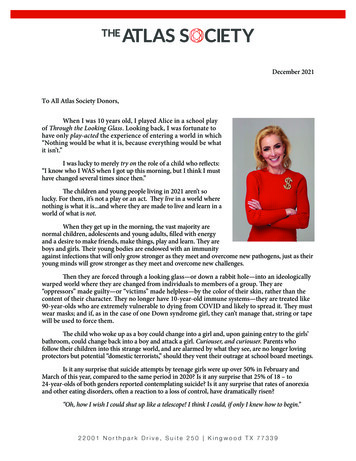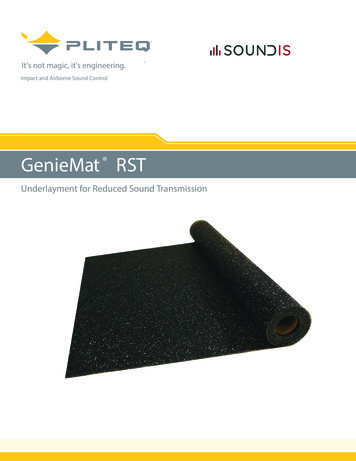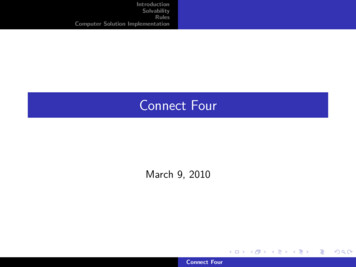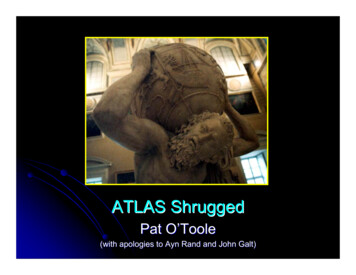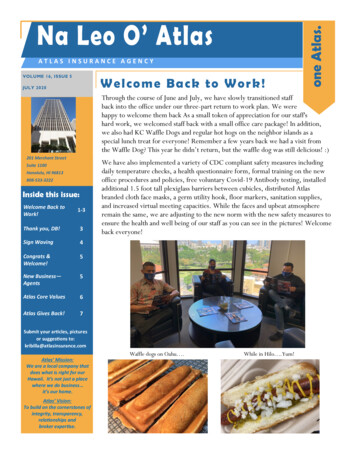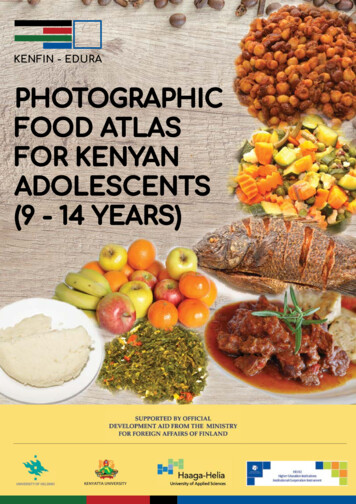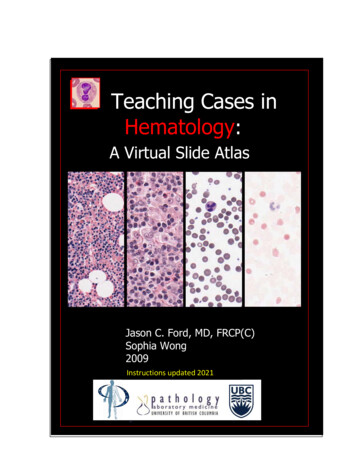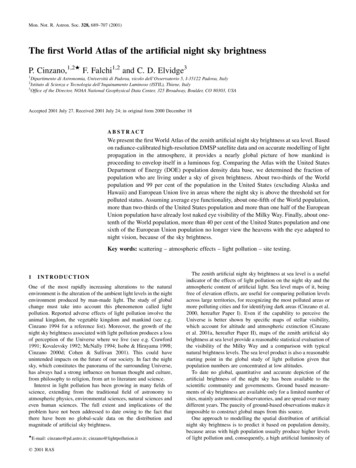
Transcription
Mon. Not. R. Astron. Soc. 328, 689–707 (2001)The first World Atlas of the artificial night sky brightnessP. Cinzano,1,2P F. Falchi1,2 and C. D. Elvidge31Dipartimento di Astronomia, Università di Padova, vicolo dell’Osservatorio 5, I-35122 Padova, ItalyIstituto di Scienza e Tecnologia dell’Inquinamento Luminoso (ISTIL), Thiene, Italy3Office of the Director, NOAA National Geophysical Data Center, 325 Broadway, Boulder, CO 80303, USA2Accepted 2001 July 27. Received 2001 July 24; in original form 2000 December 18A B S T R AC TWe present the first World Atlas of the zenith artificial night sky brightness at sea level. Basedon radiance-calibrated high-resolution DMSP satellite data and on accurate modelling of lightpropagation in the atmosphere, it provides a nearly global picture of how mankind isproceeding to envelop itself in a luminous fog. Comparing the Atlas with the United StatesDepartment of Energy (DOE) population density data base, we determined the fraction ofpopulation who are living under a sky of given brightness. About two-thirds of the Worldpopulation and 99 per cent of the population in the United States (excluding Alaska andHawaii) and European Union live in areas where the night sky is above the threshold set forpolluted status. Assuming average eye functionality, about one-fifth of the World population,more than two-thirds of the United States population and more than one half of the EuropeanUnion population have already lost naked eye visibility of the Milky Way. Finally, about onetenth of the World population, more than 40 per cent of the United States population and onesixth of the European Union population no longer view the heavens with the eye adapted tonight vision, because of the sky brightness.Key words: scattering – atmospheric effects – light pollution – site testing.1INTRODUCTIONOne of the most rapidly increasing alterations to the naturalenvironment is the alteration of the ambient light levels in the nightenvironment produced by man-made light. The study of globalchange must take into account this phenomenon called lightpollution. Reported adverse effects of light pollution involve theanimal kingdom, the vegetable kingdom and mankind (see e.g.Cinzano 1994 for a reference list). Moreover, the growth of thenight sky brightness associated with light pollution produces a lossof perception of the Universe where we live (see e.g. Crawford1991; Kovalevsky 1992; McNally 1994; Isobe & Hirayama 1998;Cinzano 2000d; Cohen & Sullivan 2001). This could haveunintended impacts on the future of our society. In fact the nightsky, which constitutes the panorama of the surrounding Universe,has always had a strong influence on human thought and culture,from philosophy to religion, from art to literature and science.Interest in light pollution has been growing in many fields ofscience, extending from the traditional field of astronomy toatmospheric physics, environmental sciences, natural sciences andeven human sciences. The full extent and implications of theproblem have not been addressed to date owing to the fact thatthere have been no global-scale data on the distribution andmagnitude of artificial sky brightness.PE-mail: cinzano@pd.astro.it; cinzano@lightpollution.itq 2001 RASThe zenith artificial night sky brightness at sea level is a usefulindicator of the effects of light pollution on the night sky and theatmospheric content of artificial light. Sea level maps of it, beingfree of elevation effects, are useful for comparing pollution levelsacross large territories, for recognizing the most polluted areas ormore polluting cities and for identifying dark areas (Cinzano et al.2000, hereafter Paper I). Even if the capability to perceive theUniverse is better shown by specific maps of stellar visibility,which account for altitude and atmospheric extinction (Cinzanoet al. 2001a, hereafter Paper II), maps of the zenith artificial skybrightness at sea level provide a reasonable statistical evaluation ofthe visibility of the Milky Way and a comparison with typicalnatural brightness levels. The sea level product is also a reasonablestarting point in the global study of light pollution given thatpopulation numbers are concentrated at low altitudes.To date no global, quantitative and accurate depiction of theartificial brightness of the night sky has been available to thescientific community and governments. Ground based measurements of sky brightness are available only for a limited number ofsites, mainly astronomical observatories, and are spread over manydifferent years. The paucity of ground-based observations makes itimpossible to construct global maps from this source.One approach to modelling the spatial distribution of artificialnight sky brightness is to predict it based on population density,because areas with high population usually produce higher levelsof light pollution and, consequently, a high artificial luminosity of
690P. Cinzano, F. Falchi and C. D. Elvidgethe night sky (sky glow). However (i) the apparent proportionalitybetween population and sky glow breaks down going from largescales to smaller scales and looking in more detail, owing to theatmospheric propagation of light pollution large distances from thesources, (ii) the upward light emission is not always proportional tothe population (e.g. owing to differences in development andlighting practices), (iii) some polluting sources are not representedin population data (e.g. industrial sites and gas flares) and (iv)population census data are not collected using uniform techniques,timetables or administrative reporting units around the World.As an alternative, we have used a global map of top ofatmosphere radiances from man-made light sources produce usingdata from the US Air Force Defence Meteorological SatelliteProgram (DMSP) Operational Linescan System (OLS) to modelartificial sky brightness. From 1972–92 only film data wereavailable from the DMSP-OLS. Sullivan (1989, 1991) wassuccessful in producing a global map of light sources using filmdata, but this product did not distinguish between the persistentlight sources of cities and the ephemeral lights of events such asfire. In the mid-1990s Elvidge et al. (1997a,b,c) produced a globalcloud-free composite of lights using a time-series of DMSP nighttime observations, identifying the locations of persistent lightsources. This potential use of these ‘stable lights’ for light pollutionstudies was noted by Isobe & Hamamura (1998). More recently aradiance-calibrated global map of man-made light sources hasbeen produced using DMSP-OLS data collected at reduced gainsettings (Elvidge et al. 1999, 2001). With both the location and topof atmosphere radiances mapped, the stage was set to modelartificial sky brightness across the surface of the World.The first exploration of these data for predicting artificial skybrightness was made by applying simple light pollutionpropagation laws to the satellite data (Falchi 1998; Falchi &Cinzano 2000). Subsequently we introduced a method to map theartificial sky brightness (Paper I) and naked-eye star visibility(Paper II) across large territories, computing the propagation oflight inside the atmosphere using the detailed Garstang Models(Garstang 1984, 1986, 1989a,b, 1991, 2000; see also Cinzano2000a,b). Here we present the first World Atlas of the zenithartificial night sky brightness at sea level. It has been obtained byapplying the method discussed in Paper I to global high-resolutionradiance-calibrated DMSP satellite data. In Section 2 wesummarize the outline of the method, in Section 3 we present theAtlas and a comparison with Earth-based measurements, in Section4 we present statistical results and tables based on a comparisonwith the Landscan 2000 DOE population density data base(Dobson et al. 2000) and in Section 5 we draw our conclusions.2OUTLINES OF THE METHODHere we summarize the methods used to produce the World Atlas.We refer the readers to Paper I and Paper II for a detaileddiscussion.High-resolution upward flux data have been calculated fromradiances observed by the Operational Linescan System (OLS)carried by the DMSP satellites. The OLS is an oscillating scanradiometer with low-light visible and thermal infrared (TIR)imaging capabilities (Lieske 1981). At night the OLS uses aphotomultiplier tube (PMT), attached to a 20-cm reflectortelescope, to intensify the visible band signals. It has a broadspectral response from 440 to 940 nm with highest sensitivity in the500- to 650-nm region, covering the range for primary emissionsfrom the most widely used lamps for external lighting: mercuryvapour (545 and 575 nm), high-pressure sodium (from 540 to630 nm) and low-pressure sodium (589 nm). We used a global mapof radiances produced using 28 nights of data collected in 1996–97at reduced gain levels, to avoid saturation in urban centres. Theglobal map is a ‘cloud-free’ composite, meaning that only cloudfree observations were used. The map reports the average radianceobserved from the set of cloud-free observations. Ephemeral lightsproduced by fires and random noise events were removed bydeleting lights that occurred in the same place less than three times.Calibrated upward fluxes per unit solid angle toward the satellitehave been obtained from radiance data based on a pre-flightirradiance calibration of the OLS PMT. The calibration was testedFigure 1. Artificial night sky brightness at sea level in the World. The map has been computed for the photometric astronomical V band, at the zenith, for aclean atmosphere with an aerosol clarity coefficient K ¼ 1. The calibration refers to 1996–1997. Country boundaries are approximate.q 2001 RAS, MNRAS 328, 689–707
First World artificial night sky brightness atlaswith Earth-based measurements in Paper I. The upward flux perunit solid angle in other directions was estimated based on anaverage normalized emission function, in agreement with a studyof the upward flux per unit solid angle per inhabitant of a largenumber of cities at different distances from the satellite nadir.The propagation of light pollution is computed with theGarstang modelling techniques taking into account Rayleighscattering by molecules, Mie scattering by aerosols, atmosphericextinction along light paths and Earth curvature. We neglectedthird and higher order scattering, which can be significant only foroptical thicknesses higher than ours. We associated the predictionswith well-defined parameters related to the aerosol content, so theatmospheric conditions, which predictions involve, are wellknown. Atmospheric conditions are variable and a carefulevaluation of the ‘typical’ atmospheric condition in the local‘typical’ clear night of each area is quite difficult, even regardingthe difficulty to define it, so we used the same atmospheric modeleverywhere, corresponding to a standard clean atmosphere(Garstang 1986, 1989; Paper I; Paper II). This also avoidsconfusion between effects arising from light pollution and effectsarising from geographic gradients of atmospheric conditions in‘typical’ nights. Being more interested in understanding andcomparing light pollution distributions than in predicting theeffective sky brightness for observational purposes, we computedthe artificial sky brightness at sea level, in order to avoid theintroduction of altitude effects into our maps. Readers should691consider these differences when interpreting the Atlas results andthe related statistics.3R E S U LT SThe World Atlas of the Sea Level Artificial Night Sky Brightnesshas been computed for the photometric astronomical V band, at thezenith, for a clean atmosphere with an aerosol clarity coefficientK ¼ 1, where K is a coefficient which measures the aerosol contentof the atmosphere (Garstang 1986), corresponding to a verticalextinction Dm ¼ 0:33 mag in the V band, a horizontal visibilityDx ¼ 26 km and an optical depth t ¼ 0:3. The maps of eachcontinent are shown in Figs 1 – 9 in latitude/longitude projection.The original high-resolution maps of the World Atlas aredownloadable as zipped TIFF files from site http://www.lightpollution.it/dmsp/ on the World Wide Web. They have beenobtained with a mosaic of the original 30 30 arcsec2 pixel sizemaps. Each map level is three times larger than the previous one.The map levels correspond to the artificial sky brightnesses(between brackets the respective colours) in V ph cm22 s21 sr21:9:47 106 –2:84 107 (blue), 2:84 107 –8:61 107 (green),8:61 107 –2:58 108 (yellow), 2:58 108 –7:75 108 (orange),7:75 108 –2:32 109 (red), .2:32 109 (white), or in m cd m22:27:7–83:2 (blue), 83:2–252 (green), 252–756 (yellow), 756–2268(orange), 2268–6804 (red), .6804 (white)(based on the conversionin Garstang 1986, 1989). For the dark grey level see below. TheFigure 2. Artificial night sky brightness at sea level for North America. The map has been computed for the photometric astronomical V band, at the zenith, fora clean atmosphere with an aerosol clarity coefficient K ¼ 1. The calibration refers to 1996–1997. Country boundaries are approximate.q 2001 RAS, MNRAS 328, 689–707
692P. Cinzano, F. Falchi and C. D. Elvidgemap levels can be expressed more intuitively as ratios between theartificial sky brightness and the reference natural sky brightness.The natural night sky brightness depends on the geographicalposition, the solar activity, the time from the sunset and the sky areaobserved (see e.g. Paper II), so we referred the levels in our maps toan average sky brightness below the atmosphere ofbn ¼ 8:61 107 V ph cm22 s21 sr21 , corresponding approximatelyto 21.6 V mag arcsec22 or 252 mcd m22 (Garstang 1986). In thiscase the map levels became 0:11–0:33 (blue), 0:33–1 (green), 1–3(yellow), 3–9 (orange), 9–27 (red) and . 27 (white). Countryboundaries are approximate. In order to show how far the lightpollution propagates from sources, we coloured in dark grey areaswhere the artificial sky brightness is greater than 1 per cent ofthe reference natural brightness (i.e. greater than 8:61 105 V ph cm22 s21 sr21 or 2.5 m cd m22). In these areas the nightsky can be considered unpolluted at the zenith but at lowerelevations pollution might not be negligible and uncontrolledgrowth of light pollution will endanger even the zenith sky. ThisFigure 3. Artificial night sky brightness at sea level for South America. The map has been computed for the photometric astronomical V band, at the zenith, fora clean atmosphere with an aerosol clarity coefficient K ¼ 1. The calibration refers to 1996–1997. Country boundaries are approximate.q 2001 RAS, MNRAS 328, 689–707
First World artificial night sky brightness atlaslevel must be considered only an indication, because smalldifferences in atmospheric conditions can produce large differences where the gradient of artificial brightness is small.The resolution of the atlas does not correspond directly to theDMSP-OLS pixel size. The effective instantaneous field of view(EIFOV) of OLS-PMT is larger than the pixel-to-pixel groundsample distance maintained by the along-track OLS sinusoidalscan and the electronic sampling of the signal from the individualscan lines. Moreover the original data have been ‘smoothed’ by onboard averaging of 5 pixel by 5 pixel blocks, yielding a groundsample distance of 2.8 km. During geolocation the OLS pixelvalues are used to fill 30-arcsec grids, which are composited togenerate the global 30-arcsec grid. However, since the sky693brightness is frequently produced by the sum of manycontributions from distant sources, the lower resolution of theupward flux data commonly does not play a role and the mapresolution mainly corresponds to the 30-arcsec grid cell size,which at the equator is 0.927 km.The satellite data also record the offshore lights where oil andgas production is active (visible e.g. in the North Sea, Chinese Seaand Arabic Gulf), other natural gas flares (visible e.g. in Nigeria)and the fishing fleets (visible e.g. near the coast of Argentina, in theJapan Sea and near Malacca). Their upward emission functionslikely differ from the average emission function of the urban nighttime lighting so that the predictions of their effects have someuncertainty. The presence of snow could also add some uncertaintyFigure 4. Artificial night sky brightness at sea level for Europe. The map has been computed for the photometric astronomical V band, at the zenith, for a cleanatmosphere with an aerosol clarity coefficient K ¼ 1. The calibration refers to 1996–1997. Country boundaries are approximate.q 2001 RAS, MNRAS 328, 689–707
694P. Cinzano, F. Falchi and C. D. Elvidge(see Paper I). For this reasons we neglected territories near thepoles.The differences between the levels for Europe in Fig. 4, based onthe pre-flight OLS-PMT radiance calibration and referring to1996–1997, and in figs 11 and 12 of Paper I, based on calibrationwith Earth-based measurements and referring to 1998–1999, agreewith the yearly growth of light pollution measured in Europe (seee.g. Cinzano 2000c) but they cannot be considered significantbecause they are within the uncertainties of the method.A comparison between map predictions and Earth-based skybrightness measurements is presented in Fig. 10. The left panelshows map predictions versus artificial night sky brightnessmeasurements at the bottom of the atmosphere taken in clean orphotometric nights in the V band for Europe (filled squares), NorthAmerica (open triangles), South America (open rhombi), Africa(filled triangles) and Asia (filled circle) (Catanzaro & Catalano2000; Della Prugna 1999; Falchi 1998; Favero et al. 2000; Massey& Foltz 2000; Nawar et al. 1998a; Nawar, Morcos & Mikhail1998b; Piersimoni, Di Paolantonio & Brocato 2000; Poretti &Scardia 2000; Zitelli 2000). All of them have been taken in1996–1997, except those for Europe which have been taken in1998–1999 and rescaled to 1996–1997 by subtracting 20 per centin order to account approximately for the growth of light pollutionin two years. Error bars account for measurement errors and for anuncertainty of about 0.1 mag arcsec2 in the subtracted natural skybrightness, which is non-negligible in dark sites. These are smallerFigure 5. Artificial night sky brightness at sea level for Africa. The map has been computed for the photometric astronomical V band, at the zenith, for a cleanatmosphere with an aerosol clarity coefficient K ¼ 1. The calibration refers to 1996–1997. Country boundaries are approximate.q 2001 RAS, MNRAS 328, 689–707
First World artificial night sky brightness atlasthan the effects of fluctuations in atmospheric conditions. The rightpanel shows map predictions versus photographic measurementstaken in Japan in the period 1987–1991 with variable atmosphericaerosol content (Kosai, Isobe & Nakayama 1992). They arecalibrated to the top of the atmosphere and averaged for each site,695neglecting those where fewer than five measurements were taken.The large error bars show the effects of changes in the atmosphericaerosol content and in the extinction of the light of the comparisonstar. The dashed line shows the linear regression. A worldwideproject of the International Dark-Sky Association (IDA) isFigure 6. Artificial night sky brightness at sea level for West Asia. The map has been computed for the photometric astronomical V band, at the zenith, for aclean atmosphere with an aerosol clarity coefficient K ¼ 1. The calibration refers to 1996–1997. Country boundaries are approximate.q 2001 RAS, MNRAS 328, 689–707
696P. Cinzano, F. Falchi and C. D. Elvidgecollecting a large number of accurate CCD measurements of skybrightness together with the aerosol content, which could bevaluable for testing future improvements in the modelling ofartificial sky brightness (Cinzano & Falchi 2000).4S TAT I S T I C SWe compared our Atlas with the Landscan 2000 DOE globalpopulation density data base (Dobson et al. 2000), which has thesame 30-arcsec grid cell size as our Atlas. We checked the spatialmatch of our Atlas against the Landscan data by visual inspectionof the superimposition of the two data sets. We extracted statisticsfor each individual countries, for the European Union and for theWorld, tallying the percentage population who on standard clearatmosphere nights are living inside each level of our Atlas.Additionally we tallied the percentage population living under aFigure 7. Artificial night sky brightness at sea level for Central Asia. The map has been computed for the photometric astronomical V band, at the zenith, for aclean atmosphere with an aerosol clarity coefficient K ¼ 1. The calibration refers to 1996–1997. Country boundaries are approximate.q 2001 RAS, MNRAS 328, 689–707
First World artificial night sky brightness atlas697Figure 8. Artificial night sky brightness at sea level for East Asia. The map has been computed for the photometric astronomical V band, at the zenith, for aclean atmosphere with an aerosol clarity coefficient K ¼ 1. The calibration refers to 1996–1997. Country boundaries are approximate.sky brightness greater than several other sky brightness conditions,as described below. Table 1 shows the percentage of populationwho are living under a sky brightness greater than each level of ourAtlas in standard clean nights, i.e. the ratios between the artificialsky brightness and the reference natural sky brightness are greaterthan 0.11 (column 1), 0.33 (column 2), 1 (column 3), 3 (column 4),9 (column 5) and 27 (column 6). The table also shows the fractionof population who in standard clean nights are living under a skybrightness greater than some typical sky brightnesses: the thresholdbp to consider the night sky polluted [i.e. when the artificial skybrightness is greater than 10 per cent of the natural night skybrightness above 458 of elevation (Smith 1979)] (column 7), thesky brightness bfq measured with a first quarter moon in the bestastronomical sites (e.g. Walker 1987)(column 8), the skybrightness bm in the considered location with a first quarterq 2001 RAS, MNRAS 328, 689–707moon at 158 elevation (based on Krisciunas & Schaefer 1991) andzero light pollution (column 9), the sky brightness bfm measured onnights close to full moon in the best astronomical sites (e.g. Walker1987)(column 10) which is not much larger than the typical zenithbrightness at nautical twilight (Schaefer 1993), the threshold ofvisibility of the Milky Way for average eye capability bmw (column11), and the eye’s night vision threshold be (Garstang 1986; seealso Schaefer 1993)(column 12). Table 2 summarizes theirnumerical values.To produce the Landscan, DOE collected the best availablecensus data for each country and calculated a probabilitycoefficient for the population density of each 30-arcsec grid cell.The probability coefficient is based on slope, proximity to roads,land cover, night-time lights, and an urban density factor (Dobsonet al. 2000). The probability coefficients are used to perform a
698P. Cinzano, F. Falchi and C. D. ElvidgeTable 1. Percentage of population who are living under a sky brightness greater than given laAnguilla elizeBeninBermuda tish Virgin IslandsBruneiBulgariaBurkina FasoBurundiByelarusCaiman Islands UKCambodiaCameroonCanadaCentral African Rep.ChadChileChinaCisgiordaniaColombiaCongoCosta RicaCroatiaCubaCyprusCzech RepublicDenmarkDjiboutiDominicaDominican RepublicEcuadorEgyptEl SalvadorEquatorial GuineaEritreaEstoniaEthiopiaFalkland Islands UKFaroe IslandsFiji IslandsFinlandFranceFrench GuianaGabonGambiaGazaGeorgiaGermanyGhana(1) 0.11bn(2) 0.33bn(3) bn(4) 3bn(5) 9bn(6) 27bn(7) bp(8) bfq(9) bm(10) bfm(11) bmw(12) 42242201400053001622351020000044220000050q 2001 RAS, MNRAS 328, 689–707
First World artificial night sky brightness atlasTable 1 – continuedCountry(1) 0.11bn(2) 0.33bn(3) bn(4) 3bn(5) 9bn(6) 27bn(7) bp(8) bfq(9) bm(10) bfm(11) bmw(12) 0000033000007000016002002003012Gibraltar UKGreeceGrenadaGuadeloupeGuatemalaGuernsey iaIndonesiaIranIraqIrelandIsle of Man UKIsraelItalyIvory CoastJamaicaJapanJersey embourgMacau que FMauritaniaMayotte FMexicoMoldovaMonacoMongoliaMontenegroMontserrat etherlands AntillesNew CaledoniaNew ZealandNicaraguaNigerNigeriaNorfolk Islands AUNorth KoreaNorwayOmanq 2001 RAS, MNRAS 328, 689–707699
700P. Cinzano, F. Falchi and C. D. ElvidgeTable 1 – continuedCountryPakistanPanamaPapua New GuineaParaguayPeruPhilippinesPolandPortugalPuerto RicoQatarRomaniaRussiaRwandaSaint Kitts e NevisSaint LuciaSan MarinoSaudi ArabiaSenegalSerbiaSeychellesSierra LeoneSingaporeSlovakiaSloveniaSomaliaSouth AfricaSouth KoreaSpainSri LankaSt.Vinc.- yriaTaiwanTajikistanTanzaniaThailandTogoTrinidad and TobagoTunisiaTurkeyTurkmenistanTurks - Caicos Is. UKUgandaUkraineUnited Arab EmiratesUnited KingdomUn. States of gin islands USWestern SaharaYemenZaireZambiaZimbabweEuropean UnionThe World(1) 0.11bn(2) 0.33bn(3) bn(4) 3bn(5) 9bn(6) 27bn(7) bp(8) bfq(9) bm(10) bfm(11) bmw(12) 5443710312000000179spatial allocation of the population for all the grid cells covering acensus reporting unit (usually province). Therefore the resultingpopulation distribution represents an ambient population whichintegrates diurnal movements and collective travel habits ratherthan the residential popula
The first World Atlas of the artificial night sky brightness P. Cinzano,1,2P F. Falchi1,2 and C. D. Elvidge3 1Dipartimento di Astronomia, Universita di Padova, vicolo dell’Osservatorio 5, I-35122 Padova, Italy 2Istituto di Scienza e Tecnologia dell’Inquinamento Luminoso (ISTIL), Thiene, Italy 3Office of the Director, NOAA Nation



